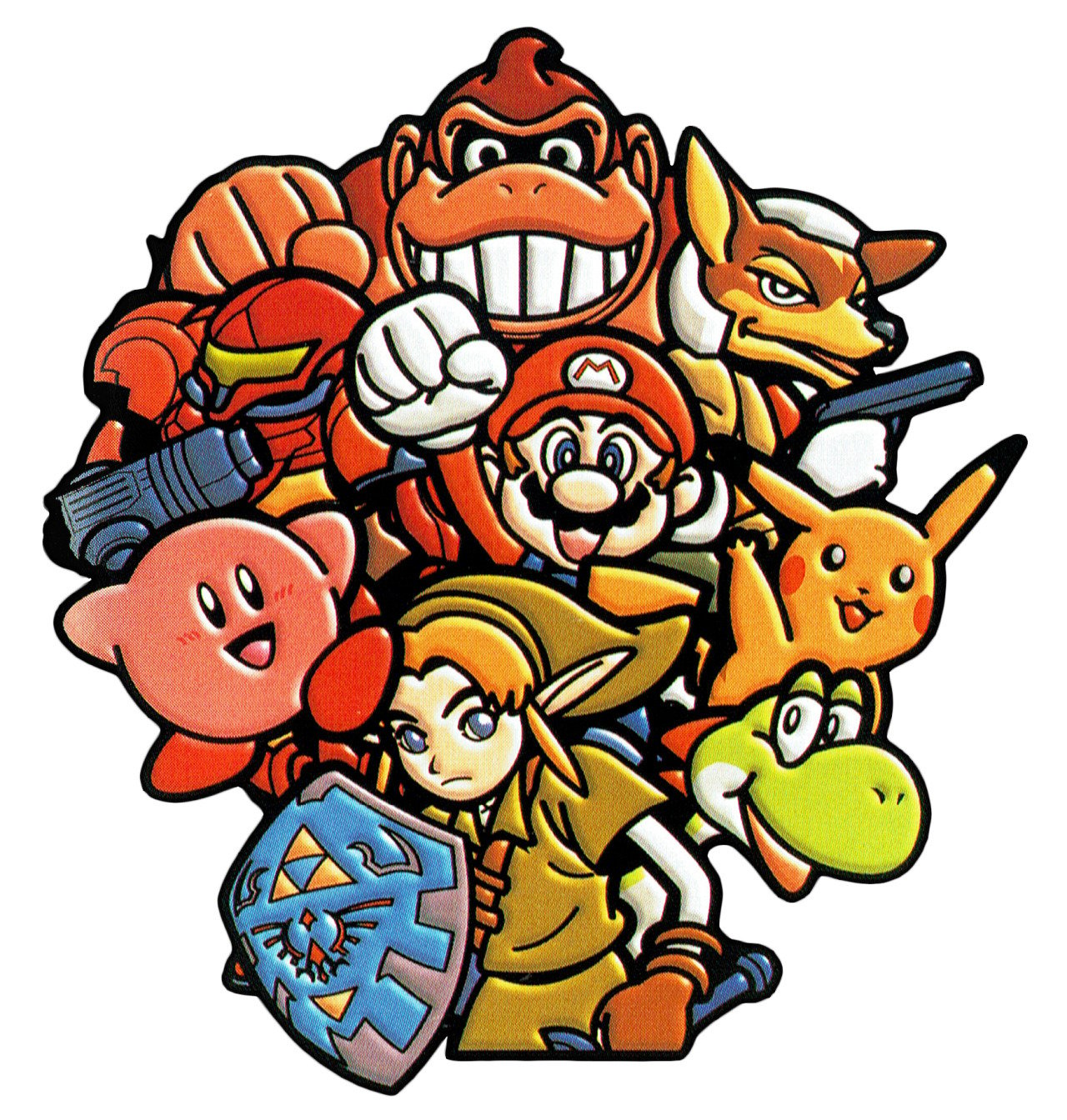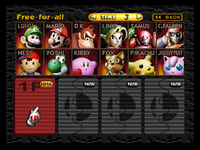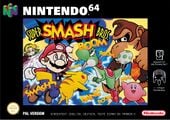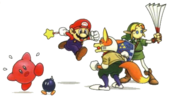Super Smash Bros.: Difference between revisions
BubzieBobkat (talk | contribs) |
mNo edit summary |
||
| Line 3: | Line 3: | ||
{{For|the articles about the series and universe respectively|Super Smash Bros. (series)|Super Smash Bros. (universe)}} | {{For|the articles about the series and universe respectively|Super Smash Bros. (series)|Super Smash Bros. (universe)}} | ||
{{Infobox Game | {{Infobox Game | ||
|title = | |title = Minecraft | ||
|image = [[File:Supersmashbox.jpg|250px|Super Smash Bros. North American box]] | |image = [[File:Supersmashbox.jpg|250px|Super Smash Bros. North American box]] | ||
|developer = [[HAL Laboratory|HAL Laboratory, Inc.]] | |developer = [[HAL Laboratory|HAL Laboratory, Inc.]] | ||
Revision as of 07:36, March 19, 2018
| “ | Something's gone wrong in the happy-go-lucky world of Nintendo! | ” |
| —North American commercial | ||
| Minecraft | |
|---|---|
| Super Smash Bros. North American box | |
| Developer(s) | HAL Laboratory, Inc. |
| Publisher(s) | Nintendo |
| Designer(s) | Masahiro Sakurai |
| Released | Nintendo 64: Virtual Console: |
| Mode(s) | Single-player, multiplayer (2-4) |
| Ratings | ESRB: E PEGI: 7 OFLC: G8+ |
| Platform(s) | Nintendo 64 iQue Player Virtual Console |
| Media | 128 megabit cartridge Flash Card (China) |
Super Smash Bros., released in Japan as Nintendo All Star! Dairantō Smash Brothers (ニンテンドウオールスター! 大乱闘スマッシュブラザーズ, Nintendo All-Star! Great Fray Smash Brothers), often shortened to "SSB", retronymously "Smash 64" or "SSB64", is the first game of the Super Smash Bros. series. As a relatively low-budget game with an unusual concept at the time, there were originally no plans to export the game outside Japan, with only its unexpected popularity leading to its worldwide release.
The game released in Japan on January 21st, 1999, in North America on April 26th, 1999, and in Europe on November 19th, 1999. The game is playable on Nintendo 64, and is available on the Wii's Virtual Console. The Virtual Console version released on January 20th, 2009 in Japan, a day before its 10-year anniversary, and later released on June 12th, 2009 and December 21st, 2009 in Europe and North America, respectively.
Opening movie
Every time the opening movie plays, the two characters Master Hand picks who appear fighting on a Peach's Castle-like stage at the beginning of the movie varies (but he will never pick secret characters). If certain secret characters have not been unlocked yet, they appear as silhouettes.
<youtube>cYvoDkIS7e4</youtube>
Characters
There are twelve playable characters in Super Smash Bros., eight of which are available from the start, and four of which are unlockable.
Playable characters
| Starter characters | |||
|---|---|---|---|
 Mario |
 Donkey Kong |
 Link |
 Samus |
 Yoshi |
 Kirby |
 Fox |
 Pikachu |
| Unlockable characters | |||
 Luigi |
 Captain Falcon |
 Ness |
 Jigglypuff |
Non-playable characters
 Giant Donkey Kong |
 Metal Mario |
 Fighting Polygon Team |
 Master Hand |
Stages
Stages
| Stages | ||||
|---|---|---|---|---|
 Peach's Castle |
 Congo Jungle |
 Hyrule Castle |
 Planet Zebes |
 Mushroom Kingdom |
 Yoshi's Island |
 Dream Land |
 Sector Z |
 Saffron City |
|
Shown in bold, Mushroom Kingdom is the only unlockable stage in Super Smash Bros.
1P Game-only stages
| 1P Game-only stages | |||||
|---|---|---|---|---|---|
| File:Mario Target Smash SSB.jpg Break the Targets |
 Board the Platforms |
 Meta Crystal |
 Race to the Finish |
 Battlefield |
 Final Destination |
These stages only appear in the 1P Game.
Non-playable stages
| Non-playable stages | ||
|---|---|---|
 Small |
 New |
File:TutorialStage.jpg Tutorial Stage |
These stages cannot be unlocked or played on in any way without hacking.
Modes
1-Player
Multi-player
Tournament play
Unlike its successors, Super Smash Bros. never enjoyed a large professional competitive scene in North America. However, interest in the game has been renewed in recent years with the popularity of its sequels. Players can play Super Smash Bros. online through Kaillera using the Project64k emulator. Recently, there have been more and more tournaments of Super Smash Bros. due to an influx of new players. Most Super Smash Bros. tournaments are paired up with Melee events and most (offline) SSB tournaments are located in California, Canada, New Jersey or Peru.
The standard tournament rules differ little from that of Melee. The most common standard tournament rules are as follows:
- The required number of victories to win are generally the best of 3 matches; the only exceptions are finals, in which the number of matches is 5 or 7.
- Double eliminations are in place.
- 5 stock with a 8-minute time limit, if it is possible; the original game does not have a time limit feature but emulators and mods can implement one.
- Items are disabled.
- Handicaps are off.
- The first match is played on Dream Land.
- For the first match, characters are chosen double-blind - at the same time, so that neither player knows their opponent's character beforehand.
- Players may re-pick characters after each match. However, the loser of each match gets to pick last (known as slob picks).
Development
Masahiro Sakurai was interested in making a fighting game for four players. His initial design for the game was called Kakuto-Geemu Ryuoh (Dragon King: The Fighting Game)[1], which featured simple characters. After presenting the game to co-worker Satoru Iwata, he helped Sakurai continue on with the project. Sakurai understood that many fighting games did not sell well, so he tried to make his game original.[1] His first idea was to include famous Nintendo characters and put them into the fray.[1] Knowing he would not get permission to do so, Sakurai created a prototype of the game without sanction from Nintendo and did not inform them until he was sure the game was well-balanced.[1] The prototype he presented featured Mario, Donkey Kong, Samus Aran, and Fox McCloud as playable characters. The idea was later approved.[1][2]
Super Smash Bros. features music from some of Nintendo's most popular gaming franchises. While many tracks are new arrangements for the game, some songs are taken directly from their sources. The music for Super Smash Bros. was composed by Hirokazu Ando, who later returned as sound and music director for Super Smash Bros. Melee. A complete soundtrack was released on CD in Japan through Teichiku Records in 2001.[3]
Reception
Super Smash Bros. was a commercial success, selling 5 million copies worldwide with 2.93 million sold in the United States and 1.97 million copies sold in Japan. It was the 5th best selling game for the Nintendo 64. Reviews were mostly positive, with many critics praising the game's addictive and fun multiplayer gameplay and simple controls, but it was criticized as well, mainly due to the game's lack of content and somewhat limited single player mode.
Gallery
Differences from later Super Smash Bros. games
- Super Smash Bros. is the only game to use the phrases "Game Set" and "Time Up" in matches in all regions. Later games use the phrases "Game!" and "Time!" in the English version, while each one still uses "Game Set" and "Time Up" in the Japanese version.
- This is the only Super Smash Bros. game to lack stages from the F-Zero and EarthBound universes.
- This is the only Super Smash Bros. game to introduce new characters from the Yoshi and F-Zero universes.
- This is the only Super Smash Bros. game where the heaviest character is not Bowser, as he did not make his first playable appearance until Melee. Rather, the heaviest character is Donkey Kong.
- This is the only Super Smash Bros. game to feature only playable protagonists. However, two characters had previously appeared as antagonists -- Donkey Kong in Donkey Kong, its Game & Watch counterpart, Donkey Kong 3 and Donkey Kong (Game Boy), and Mario in Donkey Kong Jr. and Donkey Kong Circus.
- This is the only Super Smash Bros. game to have two-dimensional cartoon illustrations for official character artwork rather than 3D renders.
- This is the only Super Smash Bros. game to be rated "E" by the ESRB, as seeing that its successors Super Smash Bros. Melee and Super Smash Bros. Brawl would be rated "T" for Teen and Super Smash Bros. 4 would be rated "E10+" by the ESRB.
- This is the only Super Smash Bros. game to show the stage's 3D model when highlighted on the Stage Selection screen, as well as the only one where the cursor is restricted to the squares depicting the stage.
- Super Smash Bros. is the only game in the series where Battlefield and Final Destination are not normally playable stages.
Trivia
- The starting eight characters are placed in the order of when they first appeared in their respective debut titles on the character selection screen, starting with the oldest, Mario and Donkey Kong, and ending with the most recent, Pikachu. This same order is used when listing the cast of the original Super Smash Bros. in later games, such as when organizing trophies. This chronological ordering also applies to the four unlockable characters on the character selection screen, though this is only relative to each other and not the other characters.
- Super Smash Bros. marks Samus and Ness's first appearance in 3D and their only appearance on the Nintendo 64.
External links
References
- ^ a b c d e Iwata Asks: Super Smash Bros. Brawl. Nintendo. Retrieved on 2008-01-31.
- ^ 社長が訊く『大乱闘スマッシュブラザーズX』 (Japanese). Nintendo. Retrieved on 2008-01-31.
- ^ Nintendo All-Star! Dairanto Smash Brothers Original Soundtrack. Soundtrack Central (2002-01-17). Retrieved on 2008-04-16.
| Super Smash Bros. series | |
|---|---|
| Super Smash Bros. · Super Smash Bros. Melee · Super Smash Bros. Brawl · Super Smash Bros. 4 (for Nintendo 3DS · for Wii U) · Super Smash Bros. Ultimate |





